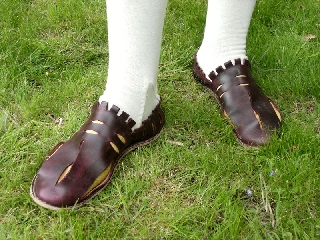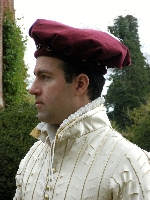I'm a huge fan of the 1560s; in fact, it's my preferred decade at the moment. Not only is there a wealth of pictorial and written evidence available all over Europe, but the cut of men's clothes in this decade do not exhibit the oddities of the fourth quarter of the decade (the absurd peascod belly being the most notable offender) but it also has (again, in my opinion) smoother and more polished lines than the previous two quarters.
Janet Arnold in Patterns of Fashion has given us a gem in the form of her analysis of Don Garzia de Medici's burial suit in 1562 (pp53-54), and this was the primary source for this suit. However, I knew that I wanted to experiment with slashing, so I took some inspiration from the French, specifically Charles IX (27 June 1550 - 30 May 1574). There are two particular portraits, attributed to Clouet, that were of great assistance to me, one currently in the Kunsthistoriches Museum in Vienna (to the right), and another in the Musee Condee in Chantilly (below this one, to the right). I went for a slightly earlier, less padded, look for the trunk hose based on some Spanish paintings at the time (Arnold, 14). |

|
Note the alternating direction of slashing on the portrait from the Musee Condee - simple gold buttons down the front, and lines of cord ornamenting the spaces between the slashes. The hat is also very similar to the painting above, and is fairly typical of the raised padded bonnet of the period.
|

|
The hat was styled after Charles' cap, but made wider to allow for flexibility with later periods. The base is cotton velveteen lined with taffeta and padded on the inside for extra stiffness. The band ornaments are commercially available buttons, which we were fortunate to discover together while on a fact finding...er, fabric finding mission at Stone Mountain Daughter in Berkeley, California.
The shirt itself is fine, medium-light weight linen; although not shown here, I originally wore this with another shirt which had a blackwork pattern on the edging of the ruff and wrists. The blackwork was a mock buttonhole design, and the interlocking design is a Venetian pattern from the third quarter of the 16th century (if I recall the research details properly, as another artisan crafted the shirt - just write me for more details if you are interested. The other unmentionable is also appropriate to the time period, and we shall leave it at that. =)
|

|
I decided on a beautiful cream duchesse satin as the outer layer for the suit - thank goodness that Thai Silks was having a 25% off sale at the time. The panes were backed with a similarly coloured cream silk taffeta and interlined with gold silk taffeta. The doublet was also interlined with gold taffeta and lined with linen quilted with a thin layer of cotton bombast. The trunk hose outerlining is the same gold taffeta and filled with polyester batting (I recall seeing wool bombast, but didn't purchase it at the time; my attempts to find it again were unsucessful, and I was working on a deadline!
The buttons are standard commercially available ones, and the gold braid is a metallic braid, found at (of all places!) Jo-Ann's Fabric Store. Over 150 yards of braid were applied on the panes, sleeves, and doublet of the suit. That's more than the length of a football field and a half, just for reference.
|

|
The points are fingerlooped braid of dark and light gold silk. They are tipped by brass aglets of my own creation, rolled out of 0.01" thick brass around a conical dowel. The pocketbags are historical - just see Arnold for more details.
|

|
The hose are of a fine knit wool, which I was fortunate to find at Stone Mountain Daughter. They're pointed to the trunk hose by means of an eyeleting strip on both hoses, something Arnold observes in her observations of some later garments (pp90-92). They're sewn with the characteristic upside-down "V" at the side of the ankle that is easily observed in many portraits and of the time, and documented in Textiles and Clothing: 1150-1450 by Crowfoot, Pritchard and Staniland (189). Unfortunately, I did not have time to set in the eyeleting holes at the correct level, which is why there is a good amount of wrinkling observed. With the eyelet strip set lower into the hose, a smooth look, much closer to portraiture of the time, is achieved.
The shoes are of vegetable tanned cattle, and are of welted construction with the welt laying flat out instead of being tucked under the insole. The shoes are lined with gold taffeta and pickadils and slashes are incorporated into the design, as with many shoes in the third quarter of the 16th century.
|

|
This outfit would not have been possible without the assistance and various members of the Society:
Maestra Francesca von Hesse for creation of the hat.
Lady Katherine Stormberg for creation and embroidery of the shirt.
Lady Katherine de Langlei, who spent many hours embroidering the cloak as a surprise gift for my elevation.
Lady Renee of Crosston for the creation of the fingerloop braids.
Lady Johanna Ludwiger von Hertesbergk who assembled the hosen.
Lady Sarah Wydville, who helped greatly with reworking, buttonholes, and eyelets.
Master Geoffrey Mathias, for helping with the final stages of stitching the insole and outsole to the upper.
Master Moshe Avenicmel, Mistress Angharad St. George, Mistress Elizabeth of Dendermonde, Signora Vittoria Aureli, Lady Agnes de Sainte-Claire, and several other members of the Society who helped with eyelets, couching, and various other elements of handsewing.
|

|









